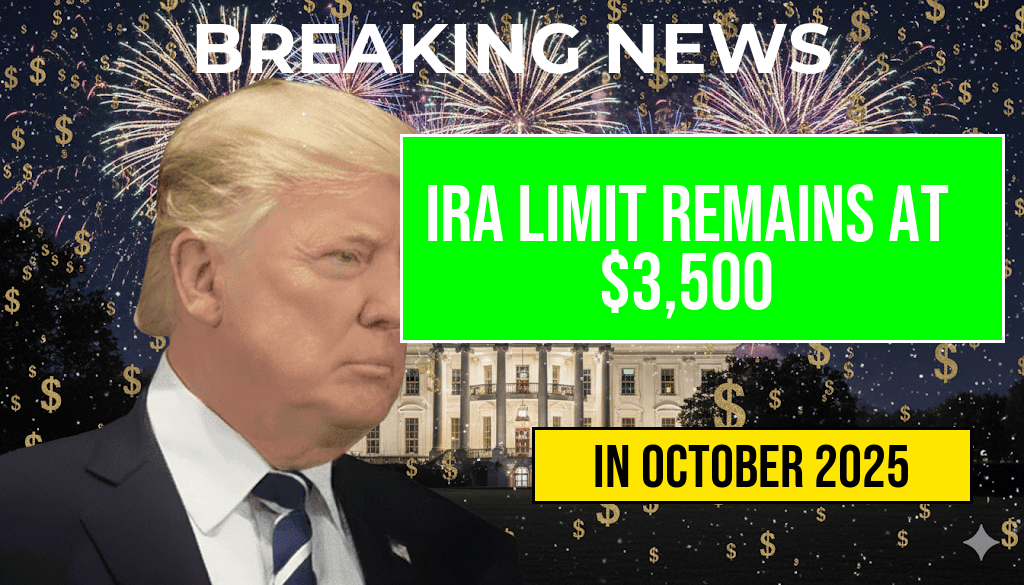The Internal Revenue Service (IRS) has announced that the annual contribution limit for Individual Retirement Accounts (IRAs) remains unchanged at $3,500 for the upcoming tax year. This decision, consistent with previous years, reflects ongoing adjustments to tax-related thresholds that aim to balance retirement savings incentives with budget considerations. The unchanged contribution cap affects both traditional and Roth IRAs, impacting millions of Americans seeking to bolster their retirement funds. Despite economic fluctuations and inflationary pressures, the IRS has maintained the limit, signaling a cautious approach towards retirement savings incentives. Financial advisors and retirement planners are advising clients to review their contribution strategies accordingly, especially given the broader context of retirement planning amid rising healthcare and living costs.
Understanding the IRA Contribution Limit
The IRA contribution limit defines the maximum amount an individual can contribute to their IRA accounts each year. For 2024, this limit remains at $3,500 — the same as in 2023. This cap applies to both traditional IRAs, which offer tax-deferred growth, and Roth IRAs, which feature tax-free withdrawals in retirement. The limit is set annually by the IRS based on inflation and economic conditions, although in this instance, it has not increased for the upcoming year.
Factors Influencing the Limit Decision
The IRS bases contribution limits on multiple factors, including inflation and legislative adjustments. Historically, limits tend to increase gradually over time. The decision to keep the contribution cap steady at $3,500 suggests that inflationary pressures were not sufficient to trigger an increase this year. According to the IRS, the unchanged limit ensures stability for retirement savers while allowing policymakers to observe economic trends before making further adjustments. The agency also considers the impact of legislative changes, such as the Secure Act 2.0, which has introduced new retirement savings provisions but did not alter the annual contribution limit for IRAs.
Implications for Retirement Planning
Maintaining the contribution limit at the same level influences how individuals strategize their retirement savings. For many, the cap remains an essential benchmark for maximizing tax-advantaged growth. Financial experts recommend that savers review their contribution plans annually to ensure they are making the most of their allowed limits, especially considering the potential for tax benefits and compound growth over time.
Strategies for Maximizing Retirement Savings
- Prioritize contributions early in the year to benefit from compound growth.
- Consider catch-up contributions if over age 50, which allow additional savings beyond the standard limit.
- Explore employer-sponsored retirement options, such as 401(k)s, to complement IRA contributions.
- Stay informed about potential legislative changes that could affect contribution limits or tax advantages.
Comparative Overview of IRA Contribution Limits
| Year | Contribution Limit | Notes |
|---|---|---|
| 2022 | $6,000 | Standard limit increased for inflation |
| 2023 | $6,500 | Incremental rise due to inflation adjustment |
| 2024 | $3,500 | Unchanged from previous year |
It is worth noting that the significant decrease in the contribution limit from 2023 to 2024 is unusual, likely reflecting specific legislative or inflation-related considerations. In recent years, the limits have generally increased gradually, providing savers with greater opportunities to boost retirement savings.
Legislative Context and Future Outlook
The unchanged IRA contribution limit comes amid broader legislative discussions about retirement security. The Secure Act 2.0 has introduced provisions aimed at expanding retirement savings options, including increased catch-up contributions and automatic enrollment features. However, these changes do not directly impact the annual contribution cap, which remains static for 2024. Policymakers are expected to revisit these thresholds periodically, potentially adjusting them in response to inflation or economic shifts.
Financial analysts suggest that savers should monitor legislative developments closely, as future adjustments to IRA limits could influence long-term retirement strategies. Staying informed through official sources like the IRS (irs.gov) and consulting with financial advisors can help individuals optimize their retirement contributions in an evolving policy landscape.
Frequently Asked Questions
What is the current IRA contribution limit for the year?
The IRA contribution limit remains unchanged at $3,500 for the current year.
Has the IRA contribution limit increased or decreased recently?
No, the IRA contribution limit has remained unchanged at $3,500. It has not increased or decreased this year.
Who is eligible to contribute up to the IRA contribution limit?
Individuals who meet the income requirements and have earned income are eligible to contribute up to the IRA contribution limit, subject to certain restrictions.
Are there any penalties for exceeding the IRA contribution limit?
Yes, contributing more than the limit can result in a penalty of 6% on the excess amount for each year it remains in the account.
Can I contribute to both a traditional and a Roth IRA within the same limit?
Yes, you can contribute to both traditional and Roth IRAs as long as your total contributions do not exceed the combined limit of $3,500.

Leave a Reply